Iran expects to start producing electricity from the heat of the earth less than a year from now as it takes steps to slowly move away from fossil fuel power stations that account for more than 80% of its installed power capacity.
Hamid Chitchian, the energy minister, said the country's first geothermal power plant in Meshgin Shahr, Ardebil Province near the Azerbaijan border in the northwest, will be launched by September 2017, IRNA reported.
The 55-megawatt plant is also billed as the first geothermal power station in the Middle East.
"Iran does not need foreign knowhow, including from Iceland, New Zealand and the Philippines to drill wells for geothermal energy," Chitchian said during a tour of the site of the power station late on Saturday.
Geothermal power plants use steam produced from reservoirs of hot water found hundreds of meters below the Earth's surface. The steam rotates a turbine that activates a generator, which produces electricity.
"The plant's turbine and generator are purchased from Italy and will be delivered in two months," the minister noted.
The plant is located on the heights of the volcanic Sabalan Mountain in the geothermal-rich Ardebil region which attracts millions of tourists for its famed hot springs which are believed to have health benefits.
Unlike thermal units that burn fossil fuels, geothermal plants produce little emissions. According to some reports, emission of carbon dioxide from geothermal power stations is less than 5% that of conventional coal-fired plants.
As of 2015, worldwide geothermal power capacity amounted to 12.8 gigawatts, of which 28% or 3,548 megawatts are installed in the US.
Turkey, one of the leading countries in the region in the geothermal industry, is planning to more than quadruple its installed capacity to 2,500 MW by 2023 from the current 620 MW.
Chitchian also hoped that Meshgin Shahr geothermal plant would help steam-related industries such as greenhouses, fish farming and tourism.
------- Four Decades Shy
With huge hydrocarbon reserves, Iran has based its power industry largely on oil and gas.
According to government data, Around 62,000 MW, or 80% of Iran's 75,000-MW output, is generated from thermal plants that burn fossil fuels. In addition, 12,000 MW comes from hydroelectric plants and 1,000 MW from the sole nuclear power plant in Bushehr.
The large investments in thermal and nuclear energy over the past four decades were made at the expense of renewable energy, including solar and wind power, which account for a total of 241 MW of Iran's total installed capacity.
Most experts consider geothermal power as a renewable resource because its source is the unlimited amount of heat generated by the Earth's core.


